Hana Taue
Sanbai (rice field deity) and Shinto Ritual
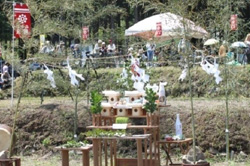 The main purpose of the hana taue ritual is to pray for a good harvest to the rice field deities. In the Geihoku area, the deity of a rice field is called sanbai. The origin of the name is not clear, but some say that it came from the pronunciation “sabae wo harau (dispel the flies that flock together in May) or “sanba no nae” (three bundles of rice seedlings), and others say that it refers to the enshrining of the three toshigami (three gods for good luck or a good harvest for that year) and sandogami (visiting the deity three times). In the old days, it was believed that when the rice planting season arrived, the deities of the rice field would visit the field to observe the planting of the rice, and then leave when the season ended. Depending on the season, this deity also turned into the gods of good harvests, tanabata (the Star Festival) and the mountain. In “Geihan Tsushi (topography of the Hiroshima clan)” which was written in the Edo period, the “sanbai festival” that was performed before rice planting is depicted as a custom belonging to Aki area (in the western part of Hiroshima prefecture). It says that wands tipped with white paper streamers were set up at water irrigation inlets and ridges between the rice fields, that farming tools were placed in an area surrounded by bamboo, and that rice placed on oak or paulownia leaves and Japanese sake poured into bottles are offered to the rice field deities, and that the men and women who planted the rice seedlings played music and sang songs. Another record from the Edo period also explains that three bundles of rice seedlings and Japanese sake poured into an unglazed vessel were supposed to have been offered to the rice field deities in the old days, even though this custom had already ceased before the record was produced. According to these records, a sacred ritual was performed beside the rice fields by the people who actually carried out the rice planting. In modern-day hana taue, Shinto rituals are not always performed in some areas of Japan. In this case, people visit their local shrine, and a Shinto priest will provide the Shinto rituals. Sanbai is a deity that, instead of being present at a shrine, visits and leaves the rice fields according to its designated season. However, as people’s perceptions about gods have changed in the way many have come to “equate gods with shrines,” the hana taue ritual has changed into a way that it does involve shrines.
The main purpose of the hana taue ritual is to pray for a good harvest to the rice field deities. In the Geihoku area, the deity of a rice field is called sanbai. The origin of the name is not clear, but some say that it came from the pronunciation “sabae wo harau (dispel the flies that flock together in May) or “sanba no nae” (three bundles of rice seedlings), and others say that it refers to the enshrining of the three toshigami (three gods for good luck or a good harvest for that year) and sandogami (visiting the deity three times). In the old days, it was believed that when the rice planting season arrived, the deities of the rice field would visit the field to observe the planting of the rice, and then leave when the season ended. Depending on the season, this deity also turned into the gods of good harvests, tanabata (the Star Festival) and the mountain. In “Geihan Tsushi (topography of the Hiroshima clan)” which was written in the Edo period, the “sanbai festival” that was performed before rice planting is depicted as a custom belonging to Aki area (in the western part of Hiroshima prefecture). It says that wands tipped with white paper streamers were set up at water irrigation inlets and ridges between the rice fields, that farming tools were placed in an area surrounded by bamboo, and that rice placed on oak or paulownia leaves and Japanese sake poured into bottles are offered to the rice field deities, and that the men and women who planted the rice seedlings played music and sang songs. Another record from the Edo period also explains that three bundles of rice seedlings and Japanese sake poured into an unglazed vessel were supposed to have been offered to the rice field deities in the old days, even though this custom had already ceased before the record was produced. According to these records, a sacred ritual was performed beside the rice fields by the people who actually carried out the rice planting. In modern-day hana taue, Shinto rituals are not always performed in some areas of Japan. In this case, people visit their local shrine, and a Shinto priest will provide the Shinto rituals. Sanbai is a deity that, instead of being present at a shrine, visits and leaves the rice fields according to its designated season. However, as people’s perceptions about gods have changed in the way many have come to “equate gods with shrines,” the hana taue ritual has changed into a way that it does involve shrines.
» Sanbai festival
Kazariushi (Decorated cows)
 Cows that plow the rice fields in hana taue are called “kazariushi (decorated cows)” or “hanaushi (flower cows).” In the old days, out of the draft cows that were used for farming work, it was only the nice-looking and well behaved cows that were specially selected for use in the hana taue festival.
Cows that plow the rice fields in hana taue are called “kazariushi (decorated cows)” or “hanaushi (flower cows).” In the old days, out of the draft cows that were used for farming work, it was only the nice-looking and well behaved cows that were specially selected for use in the hana taue festival.
After their bodies and horns are washed and brushed, the cows are beautifully decorated. This decoration is considered to be dressing up for the cows to participate in a special event.
The decorated cows are fitted with saddles called “hanagura (flower saddle)” or “kazarigura (decorated saddle).” These saddles are different from those used for ordinary farming work. The total weight of the decorations including a flag and artificial flowers is as much as 20 to 30 kg.
In addition to a saddle, the cows are decorated with kubitama (accessories), kurashita (quilt laid underneath the saddle), wagesa (a simple version of a Buddhist priest’s stole) and various other colorful materials. The popular style and ingenuity of the times can be seen in the shape of the saddles and the decorations and the ornaments.
Nowadays, most of the decorated cows belong to the “Kazariushi Preservation Association,” an organization established by volunteer cow farmers. These cows participate in taue related festivals in the surrounding areas. Instead of being used for ordinary farm work, they are usually trained to enter rice fields and to get used to being close to people and music.
» Cow decorations and accessories
Shirokaki (Plower)

Shirokaki, a plower who drives a decorated cow is one of highlights of the hana taue festival. Each plower, or so-called shirokaki or ushioi, drives a single cow.
In some areas of Japan, the rice fields are plowed using just cow’s legs only without any plowing equipment attached. In many other areas, however, rice fields are plowed by cows which are attached to harrows.
The cow which stands at the front of the team of cows is called “omouji” or “sakiuji.” As its performance determines the quality of the plowing, this cow is placed in a key position. Therefore, in the old days, a person who was good at using cows for plowing was usually the person who was asked to lead the first cow.
In hana taue, particular plowing patterns are used, and each pattern has its own name. This means that hana taue is different from ordinary taue, and so by using these particular plowing patterns, the rice field is considered to have become a “festival site.” A wide variety of different plowing patterns are used and they are recorded in a plowing pattern collection book called “shirohon.”
In the old days, a shirokaki who was good at singing made the cow plow the field while he sang the shirokaki songs. Such a scene cannot be seen today.
» Plowing pattern example
Dengaku-dan (Music and dance groups)

Songs, music, dance and the rice planting that is performed as part of the hana taue ritual are performed by local people. In the old days, most of these people were engaged in rice production. Recently, however, as a result of all the technological advances that have occurred in the agriculture industry, it is very rare for rice planting to be carried out manually or for ordinary rice planting to be performed with music.
As a result, music and dance groups and preservation associations have been established in local communities to not only perform the music and the dance, but to also pass these important cultural activities on down to the next generation. And they not only teach children the music and the dance and but they also involve with people who want to experience hana taue.
Before these organizations were formed, people who were confident in their singing and dancing ability took part in the hana taue ritual at various hana taue venues and showed their skills. These outstanding musicians and singers would have been praised in the old days. But in recent hana taue, unified movement of all dancers is highly appreciated.
People get beautifully dressed up in costumes and walk to the festival site (rice field). They perform music, sing songs and sometimes even dance on their way to the festival (michiyuki).
» Dengaku competition
Sanbai (Leader)
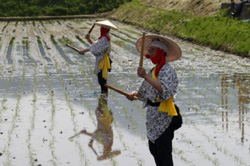
A person who takes the lead in rice planting and music in the hana taue ritual is called “sanbai” which is similar to the rice field deity “sanbai,” and sasara, a musical instrument which the leader uses to beat the time, is called “sanbai-dake.” This is because the leader is considered to play a significant role, just like that of a Shinto priest who manages festivals. The leader was also called “uta-daiku (taue uta singer),” “dengakushi (music performer)” or “sanbaso (traditional prelude performer)” a long time ago.
A person who knew the songs very well and who was good at singing them was selected to be a sanbai. Songs were selected and started by the sanbai, music started according to sanbai’s song and direction, and the saotome ladies provided a singing accompaniment to the sanbai’s song while planting rice seedlings.
In the old days, the hana taue ritual started early in the morning and lasted till late in the evening. Selecting songs according to the situation was an opportunity for the sanbai to show off his skills. The sanbai also closely observed the saotome and musicians to see how tired they were and depending on what they saw, He would either play love songs or Japanese sake songs to help them feel less tired.
On the other hand, there’s a story which say that when the sanbai made singing mistake, he had to change the direction of his sash, which hung on an angle to his shoulder, in the same way that the saotome ladies’ and musicians’ sash hung, and join the saotome ladies’ line. Or, the saotome ladies would stop planting rice and return home leaving the sanbai to work in the rice field.
» Sasara
Saotome (Rice planting ladies)
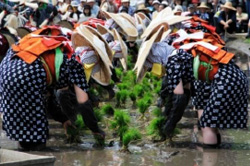
Saotome are the ladies who plant the rice seedlings in the rice field. The term “saotome” can be heard in various parts of Japan on occasions that have nothing to do with the hana taue ritual, and it usually refers to ladies who plant rice seedlings in Shinto rituals and festivals related to the rice field. So the saotome not only plant rice seedlings but also serve as shrine maidens.
In hana taue, the sanbai sing the oyauta (lead songs) and the saotome sing the kouta (following songs) which come after the sanbai’s song.
The saotome plant rice seedlings while singing the songs. These days, saotome ladies in Kitahiroshima-cho wear a costume that match the costume of the dengaku group they belong to. In the old days when the saotome came from other towns and villages, they wore their own kimono.
Some people wove and made kimono especially for the hana taue festival, and went to the trouble of changing their kimono if it got dirty.
Hana taue also served as an opportunity to introduce eligible young ladies and new brides. Saotome belonging to the Mibu Dengaku group wearing a small splashed-pattern kimono
» Saotome/Earlier costumes
Taue Uta (Rice planting songs)
Taue uta comprises a huge number of songs. This is a result that the collection of newly created songs and those songs that have been acquired from other regions and areas were added to the many different songs that have been passed down over the generations.
Hayashida songs originating from the Geihoku area started to become known nationwide at a time when songs belonging to the “Taue Zoshi,” a copy of a collection of rice planting songs, were introduced in the Taisho period (1912-1926). Since then, studies of taue uta songs have become popular.
Songs that are sung in the hana taue rituals in the Geihoku area have a characteristic called the “oroshi style.” The basic patterns of the hana taue festival songs are “oyauta and kouta,” “yuri (song, tune)” and “oroshi (sometimes called sagoe).” The sanbai, leader, first sings a song combining some of these patterns, and then the saotome follow. After singing several songs repeatedly, they take a rest called “koshi,” during which the saotome ladies sit up straight from a squatting posture to stretch their backs.
Taue uta are composed of asa-uta, sung in the morning, hiru-uta, sung in the afternoon, and ban-uta, sung in the evening. Each song has four verses.
Taue uta include songs related to the taue event processes such as “welcoming sanbai,” “picking up seedlings from the nursery (naetori),” “praising the field owner,” and “sending off onari (a lady who serves meal to the rice field deity).” There are also love songs, songs depicting historical events, scenic locations, mountains, lakes, rivers and forests of each region, and various other kinds of songs. Love songs were prohibited at one time because they were considered to be not suitable for the rice planting. Nowadays it is very rare to hear these songs.
However, love songs are interesting and have the ability to relax people. They are also considered to invoke the idea that “fertility corresponds to good harvests,” as is often seen in the taue related rituals.
The songs that used these days are selected from abundant number of songs and that have been passed down over time.
» Examples of taue uta songs and lyrics
Hayashite (Music player)
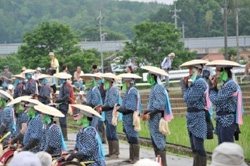
Hayashi is composed of four different kinds of instruments: a big drum, a small drum, a flute and a small gong. The small drum and small gong constantly keep in rhythm with the sanbai’s sasara, while the flute plays tunes. The big drum, which is also called “tuzumi” or “do,” is attached to the front side of the player’s lower waist and beaten with drum sticks which have white horse hair attached at both ends of the sticks. The number of big drum players is larger than that of the other instruments. In the old days, drum players came from neighboring communities and their numbers sometimes exceeded the number of saotome ladies.
There are several ways of playing the drums and gongs, and the way that they are played depends on the song played. Listening to the start of the sanbai’s beat, the musicians play their instruments in time with the sanbai’s song. The players of the big drums rotate their sticks and throw them up into the air every beat in a fixed way.
One of the taue uta lyrics says that first comes the big drums, then the flutes, then the sasara, and finally, the small drums and the gongs. Some say the musical instruments should be learned in this order. The small drums and small gongs do not apparently attract as much attention, because the players that play them are few. Their beats, however, are also still very important.
» Musicians’ musical instruments
Other Roles
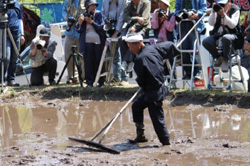
There are other roles to support hana taue. They are the “eburi (eburi pusher)” who levels the soil plowed by the cows, the “naemochi (seedling carrier) who distributes the rice seedlings to the saotome ladies, and the “tsunahiki” who arranges the shinzuna (rice planting string) which marks the locations where the seedlings are to be planted.
In addition, there were ladies called “onari” who served meals. These days, however, the rice planting process takes less time and so this role no longer exists even if food is served.
People who perform similar duties to the onari workers work at taue related events all over Japan, and they are called “hirumamochi (lunch waiters).” In some cases, this role is limited to the “daughter of a landowner” or an “unmarried woman.” This is because the onari role is believed to be a sacred role in which the onari prepares and serves offerings to the god.
There are also other roles such as the person who is in charge of the Japanese sandals before and after michiyuki parade and the person who holds the flag belonging to dengaku groups. These roles are thought to have been created when dengaku groups and preservation associations were established.
» Tools for taue
Eburi at Water Inlets
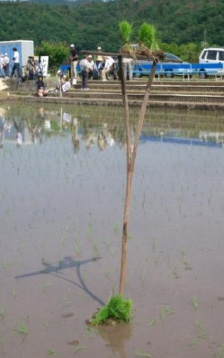
At the end of the hana taue festival, three bundles of rice seedlings are sometimes put on an upended eburi.
In the old days, an eburi was also set up at the munakuto (drain) or rice nursery even at the end of the taue festival.
The area where the eburi is erected is thought to be the place where the rice deity stays to observe the rice planting. It was thought that the deity would leave this place either at around the end of the taue season, the end of the rainy season, or around the time of the star festival.
» Eburi
Meals for the hana taue festival

Meals for the hana taue festival “Chishamomi,” which is used in the taue uta songs, is a local food belonging to the Chugoku and Shikoku regions. In “chishamomi,” chicha (lettuce) dressed in vinegar is mixed with grilled mackerel meat.
In the old days, the hana taue (otaue) festival started early in the morning and continued until late at night, during which time meals and tea (light meals) were served. In the hana taue ritual which was organized by large landowners, there were many participants and so the preparation of meals was an onerous task.
Typical foods described in the records include “kinako musubi,” round rice balls dusted with soybean flour, and salted rice balls containing black beans. These rice balls were wrapped in magnolia leaves so that they could be eaten in the rice fields.
Salted rice balls containing black beans and wrapped in magnolia leaves. Are said to have been served by ladies called onari.
In some areas, rice balls which are served in the hana taue festival are called sanbai or sanbai meshi. These kinds of food are unique to this season and they may also be ritual food that is either served as offerings to the rice deities or is eaten with the rice deities.
Related Facilities
Museum of Geihoku Folk Performing Arts and Folklore
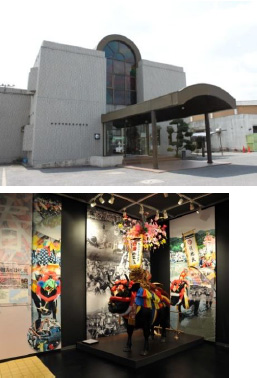
The museum exhibits material and documents relating to folklore and the lives of all the people belonging to the Geihoku area.
Open
9:00 am - 4:30 pm
Closed
Monday
(Tuesday when Monday falls on a national holiday),
and the year-end and new year holiday season
Admission fee
Adults: 300 yen (200 yen), High school students: 100 yen (50 yen), Junior high school students and under: Free
* The fees shown in the parentheses are for groups comprising 10 people or more.
Address:
1234, Arida, Kitahiroshima-cho, Yamagata-gun, Hiroshima 731-1595
Phone: +81-826-72-5088
Parking
Provided.
Road access
Expressway: Exit at the Chugoku Expressway, Chiyoda Interchange.
Express bus: Get on at Hiroshima Station or Hiroshima Bus Center and get off at the Chiyoda Interchange. Local bus: Get off at Chiyoda (Michi-no-Eki “Mai Road Inter Chiyoda”)
Contact
» Sketch of the hana taue festival (Picture: Kunnichi Kaneko)








